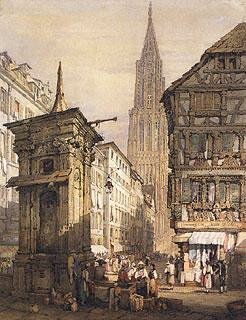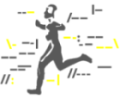|
|
|
Samuel Prout (1782-1857)
Samuel Prout, A View of Strasbourg, circa 1822. (www.handprint.com/HP/WCL/artist07.html#prout, May 30, 2004)
"Samuel Prout (1782-1857) was most famous for these travel paintings. Born in Plymouth, Prout was persuaded by the antiquary John Britton to move to London and contribute to his Beauties of England and Wales (1803-13). Prout built a reputation as drawing master in London and in his career published several watercolor drawing instruction manuals. He became an associate of the Old Water-Colour Society in 1817; in that year he first visited the Continent in search of topographical subjects, and from 1820-46, though afflicted by frequent migraine headaches, he energetically painted all the popular topographical venues in Normandy, the Low Countries, the Rhine Valley, Switzerland and Venice in a style that remained unchanged his whole life.
His works were very popular (John Ruskin as a fervent admirer), sold well, and were widely distributed as engravings and lithographs. A View of Strasbourg (c. 1822, 62 x 48cm) is a good example of his approach: the easily recognizable historical monument (the enormous red sandstone tower of the Notre-Dame cathedral) is used as the backdrop to a focus on everyday life. The people in the street are engaged in convincing everyday activities (drawing water, shopping, carrying fuel), the whole rendered primarily in ochre, umber and pale violet, gently accented by glimpses of saturated red, yellow and blue in the costumes. Prout was especially known for his wiggly, nervously mannered drawing line, which was especially effective at conveying the pocked, crumbling surfaces of old stone and wood structures. At a period when the face of London was being aggressively transformed by the modern stucco facades of the Royal architect John Nash's (1752-1835) urban renewal projects, Prout's medieval facades and quaint regional costumes provided a tasty closing variation on the charm of picturesque roughness and variety."
(Cited from Bruce MacEvoy, watercolors - the world's finest guide to watercolor painting. © 2004 Bruce MacEvoy)
Author: Klaus Podoll
Last modification of this page: Mon. May 31, 2004
 Top of the page Top of the page



|
|


|








 Top of the page
Top of the page

